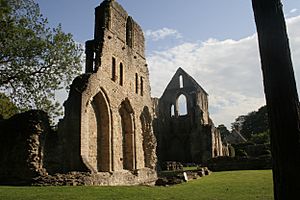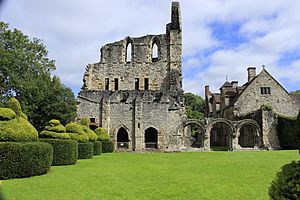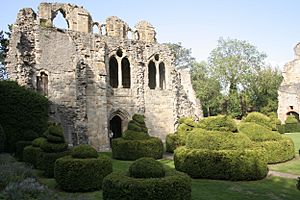Wenlock Priory facts for kids
Wenlock Priory, also known as St Milburga's Priory, is a fascinating old building in Much Wenlock, Shropshire, England. It's a ruined monastery that was built in the 12th century. A monastery is a place where monks live and worship.
This priory was part of the Cluniac order, a special group of monks. It was rebuilt between 1079 and 1082 by a person named Roger de Montgomery. This new building was put on the same spot where an even older monastery from the 7th century used to be!
People believe that Saint Milburga is buried here. Her bones were supposedly found when the priory was being fixed up in 1101.
Today, some parts of the priory became a private house called "Wenlock Abbey." But most of Wenlock Priory is open for everyone to visit! English Heritage looks after it, and people often go there to relax and explore. The gardens even have cool shaped bushes called topiary.
Contents
History of Wenlock Priory
How It Began
The very first monastery here was built around the year 680. It was founded by Merewalh, who was a king of a group called the Magonsaete. His daughter quickly became the leader of this monastery, known as an abbess. She was later made a saint.
After she passed away around 727, we don't know much about the monastery for a long time. This was until the Norman Conquest. This was when William the Conqueror and his Norman army took over England in 1066. We do know that monks lived there even after the Normans arrived.
In the 12th century, the old monastery was replaced. A new Cluniac priory was built just for men.
Building a Bigger Church
Around the year 1200, a leader of the priory named Prior Humbert got special permission from King Henry III. King Henry III sometimes visited the Priory himself! He even had his own wine stored there.
These permissions helped the monks build a much bigger and newer church. In the early 14th century, the priory church was completely rebuilt. It was made very grand and beautiful.
Today, you can still see many parts of this huge church. It was about 350 feet (107 meters) long! You can see parts like the north and south transept (the arms of the cross-shaped church) and the nave (the main part where people sat).
The Town of Much Wenlock
The town of Much Wenlock grew up around the Priory. It's a charming town with narrow, winding streets. Many buildings are old, with black and white timber frames.
In the town, there's a well named after Saint Milburga. People used to say that the water from this well could help people with poor eyesight. It was also believed to help Victorian women find a husband!
The Priory's End
The time known as the Dissolution of the Monasteries happened in 1540. This was when King Henry VIII closed down many monasteries in England.
After this, some of the buildings at Wenlock Priory were changed. The Prior's House, which was built in the late 15th century, became a private home. This house is now known as "Wenlock Abbey."




